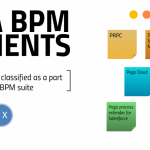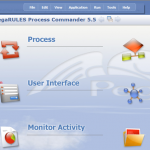Q. What is PEGA?
Pega is the software for customer centricity. Many of the world’s leading organizations use Pega to drive revenue growth, improve customer experience, and enhance operational efficiency. Pega’s unified offering is recognized by industry analysts as a leader in CRM, BPM, case management and business rules. Pega’s software complements existing systems and offers a wide range of industry applications designed to accelerate time to market.
Q. What is PEGA PRPC or What is PRPC?
PRPC (PegaRULES Process Commander) is a software product created, licensed, and marketed by Pegasystems Inc (PEGA). PRPC is the core component of Pegasystems’s “SmartBPM” suit of BPM (Business Process Management) solutions.
Q. What is PEGA PRPC or What is PRPC?
PRPC (PegaRULES Process Commander) is a software product created, licensed, and marketed by Pegasystems Inc (PEGA). PRPC is the core component of Pegasystems’s “SmartBPM” suit of BPM (Business Process Management) solutions.
PegaRULES Process Commander comes essentially as two discreet entities,
- PegaRULES : Core Java-based/Object-Oriented Rules Engine.
- Process Commander : Layers of pre-configured rules that provide a solid foundation on which to perform development and customization.
Incorporating both of the following components, PRPC addresses simple to complex business challenges:
- BPM
- Procedural processing through a user-interactive BPM / BPMS(BPM Suite) tool.
- BRE
- Declarative “On-Change” processing through an event-driven tool.
The advantages that PRPC offers from a Business perspective are as follows:
- Software platform enabling businesses the opportunity to migrate all their disparate, diverse, and often complex business rules onto one platform.
- Ability to streamline, automate, and document business processes.
- Consolidate multi-stream processes into one system.
- Through service connectors (such as SOAP, MQ, active file listening) connect to existing enterprise applications.
- Pass data between systems and have such information parsed, extracted, and interpreted.
The advantages that PRPC offers from a Developer perspective are as follows:
- Development can be achieved in small iterative-based parts
- Development is contained within heavily graphic-driven ‘Rule Forms’ that are version and ruleset controlled.
- All run-time Java code is compiled and executed by the system at run-time.
- Changes or new configurations can be tested in real-time, even on production systems without affecting other users or processes.
Ultimately PRPC is a software platform that allows businesses the opportunity to migrate all their disparate, diverse and often complex business rules, practices and processes into one platform. The platform offers the possibility of streamlining, automating and documenting business processes in a way that can truly allow consolidation of multi-stream processing into one system. Through PRPC’s myriad service connection capabilities (such as SOAP, MQ, active file listening on directories etc…), it is possible to connect already existing enterprise applications to PRPC and pass to the platform messages, data or information and have such information parsed, extracted and interpreted for use either within user driven processes, or even system-driven events.
So, what does that really mean?
Think of PRPC as a box of sophisticated Lego. You are provided with a number of building blocks that enable you to quickly and easily build an application to suite the requirements of your business. The Lego blocks (or Rules as Pegasystems calls them) represent different parts of your application. There are rules for screens, decisions, correspondence, interfacing to external systems, etc. You can take these rules and put them together to design and build your solution.
This also means that it is very simple and easy to change your solution to suit the ever changing requirements of the business – you simply change the lego bricks around!!
Q. What is Rule Engine or What is BRE (Business Rule Engine)?
A business rules engine (BRE) is a software component that allows non-programmers to add or change business logic in a business process management (BPM) system. A business rule is a statement that describes a business policy or procedure. Business logic describes the sequence of operations that is associated with data in a database to carry out the rule.
A business rules engine works by separating execution code for business rules from the rest of the business process management system. This allows the end user to change business rules without having to ask a programmer BPM development
for help. When a change is made, the engine will evaluate the change’s effect on other rules in the system and flag the user if there is a conflict.
According to authors Alex Berson and Larry Dubov, a complete business rules engine will include the following:
· Business Rule Repository – A database for storing the business rules as defined by the business users.
· Business Rule Editor – An intuitive user interface that allows business users to define, design, document and edit business rules.
· Reporting Component – An intuitive user interface that allows business users to query and report existing rules.
· Rules Engine Execution Core – The actual programming code that enforces the rules.




